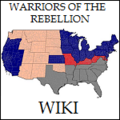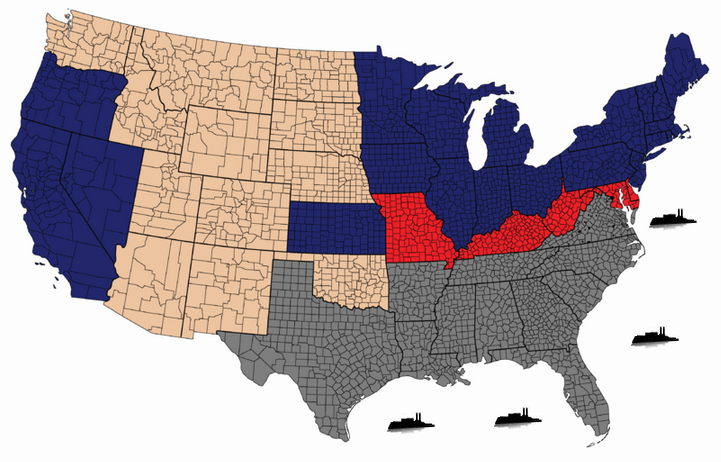Getting Started - Click a State or Fleet Below to Begin!
|
Today in the Civil War
As with any conflict, the exact beginning and end of the war are disputed. The most commonly accepted beginning of the war is the Confederate bombardment of Fort Sumter in South Carolina from April 12-14, 1861, which erupted months after southern states had started seceding and seizing federal property. Similarly, the most commonly accepted end of the war is General Lee's surrender after the Battle of Appomattox Courthouse on April 9, 1865, though organized Confederate forces in other parts of the country continued to win battles and skirmishes for months after. Many argue that the only true "end" to the war was the military ceasefire, and that our regional differences continue to divide us. This panel displays events from every day of the conflict as they happened.
1861
|
| This feature is not yet available. Check back soon for updates!
|
1862
|
- Leonard Fulton Ross is appointed Brigadier General in the Union Army
- Alfred Howe Terry is appointed Brigadier General in the Union Army
- Skirmish on the Eel River, California
- Skirmish near Fort Baker, California
- Skirmish at Neosho, Missouri
- Skirmish at Turnback Creek, Missouri
- Skirmish at Arkins' Mill, Tennessee
- Confederate Scout on the Forked Deer River, Tennessee
- Skirmish at Gordonsville and Keezletown Cross Roads, Virginia
|
1863
|
- Arthur Middleton Manigault is appointed Brigadier General in the Confederate Army
- Colonel Abel D. Streight, US Cavalry, Raid from Tuscumbia, Alabama toward Rome, Georgia (continues to May 3, 1863)
- Union Expedition to Celina, Kentucky (continues to April 29, 1863)
- Union Expedition to Monticello, Kentucky and Operations in Southeastern Kentucky (continues to May 12, 1863)
- Union Expedition from Opelousas, Louisiana toward Niblett's Bluff, Louisiana (continues to April 29, 1863)
- Affair at Altamont, Maryland
- Affair at Cranberry Summit, Maryland
- Skirmish at Oakland, Maryland
- Action at Cape Girardeau
- Skirmish at Independence, Missouri
- Skirmish near Jackson, Missouri
- Affair near College Grove, Tennesee
- Engagement at Duck River Island/Little Rock Landing, Tennessee
- Skirmish at Oak Grove Virginia
- Skirmish at Burlington, West Virginia
- Skirmish at Portland, West Virginia
- Skirmish at Rowlesburg, West Virginia
|
1864
|
- Hiram Burnham is appointed Brigadier General in the Union Army
- Major General Frederick Steele retreats from Camden, Arkansas, unable to join up with Major General Nathaniel Banks in the Camden Expedition
- Brigadier General William Birney Union expedition from Jacksonville, Florida to Lake Monroe, Florida
- Skirmish at Berwick, Louisiana
- Skirmish in Wayne County, Missouri
- Affair at Wichester, Virginia
- Union troops evacuate Washington, North Carolina after Confederate forces capture Plymouth, North Carolina
The Red River Campaign
- Skirmishes about Alexandria, Louisiana (continue until May 13, 1863) as Union troops return from Campaign
- Skirmish at Bayou Rapides Bridge near McNutt's Hill, Louisiana
- Engagement at the junction of the Cane and Red Rivers, Louisiana (continue until April 27, 1863)
- Engagement at Deloach's Bluff, Louisiana
|
1865
|
- La Fayette Curry Baker is appointed Brigadier General in the Union Army
- Union scout from Little Rock, Arkansas to the Saline River, Arkansas (continues to April 29, 1865)
- Affair near Fort Rice, Dakota Territory
- General Joseph E. Johnston surrenders the Confederate Army of Tennessee to Major General William Sherman at Bennett's House (near Durham), North Carolina after several days of negotiations. Johnston's surrender ends the war for all active Confederate troops in North Carolina, South Carolina, Georgia, and Florida
- Confederate President Jefferson Davis and his entourage set out from Charlotte, North Carolina for the Mississippi to continue the Southern Rebellion from the Western Territories
- Confederate Secretary of the Treasury G.A. Trenholm resings his cabinet post due to poor health and is replaced by Confederate Postmaster General J.H. Reagan
- Union Operations in the Shenandoah Valley (continue to May 5, 1865)
- John Wilkes Booth and David E. Herold are captured at Richard H. Garrett's farm near Port Royal and north of Bowling Green, Virginia. Booth is mortally wounded
|
|


